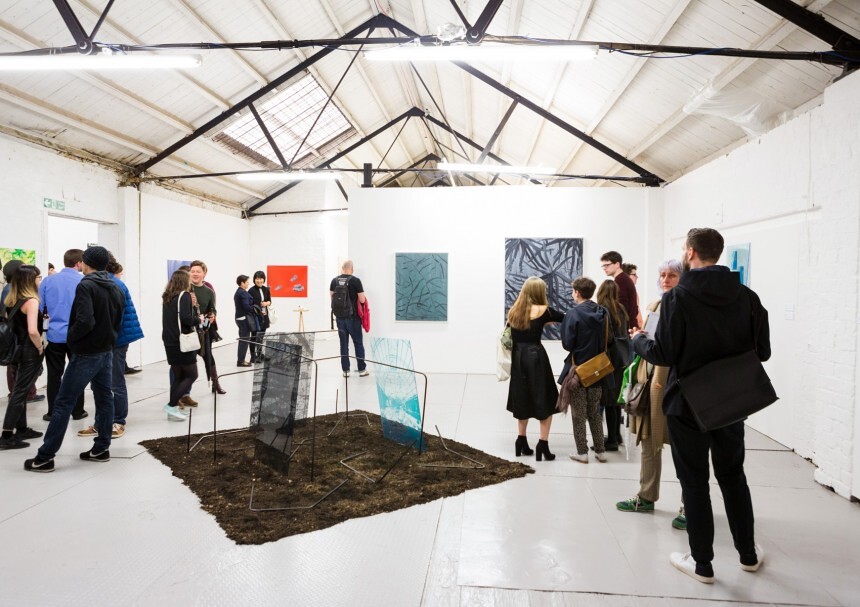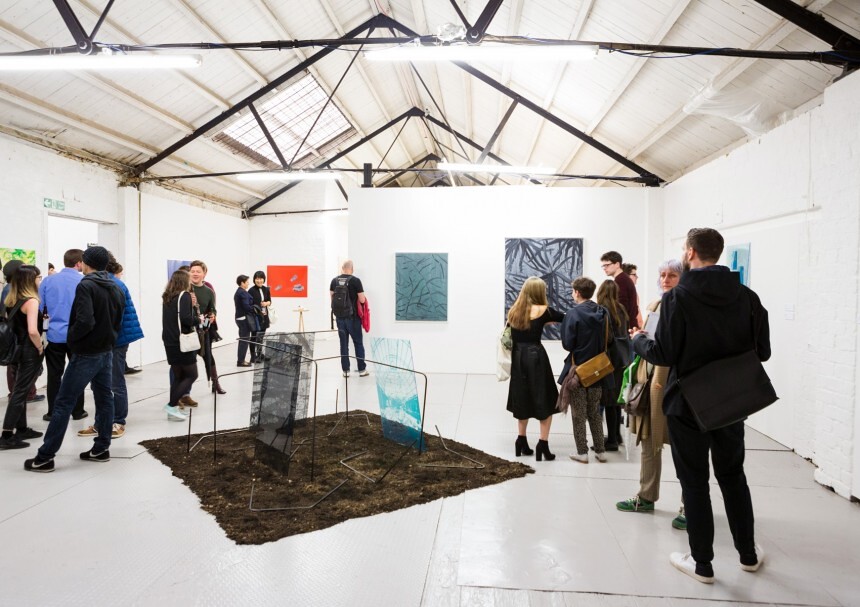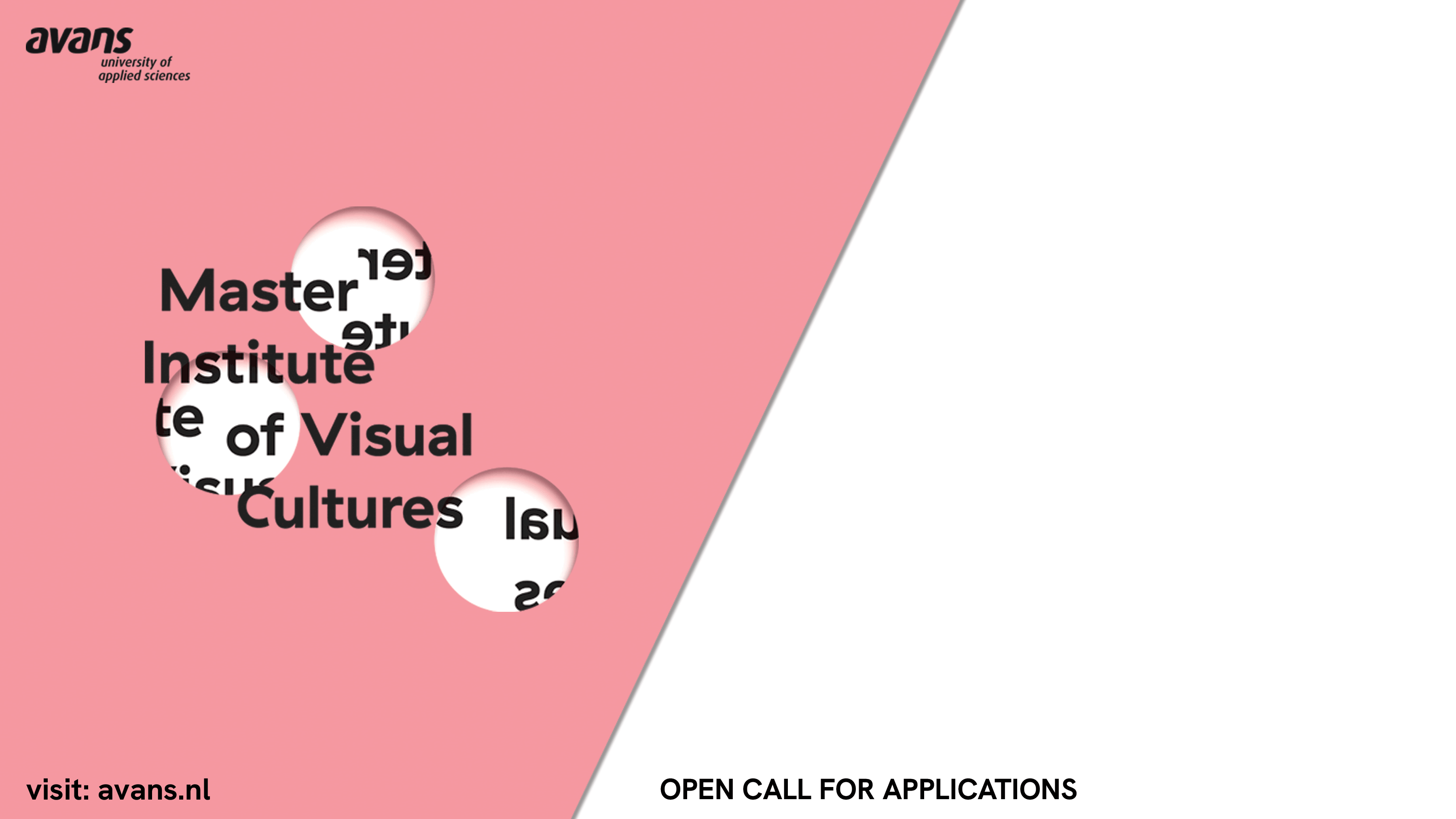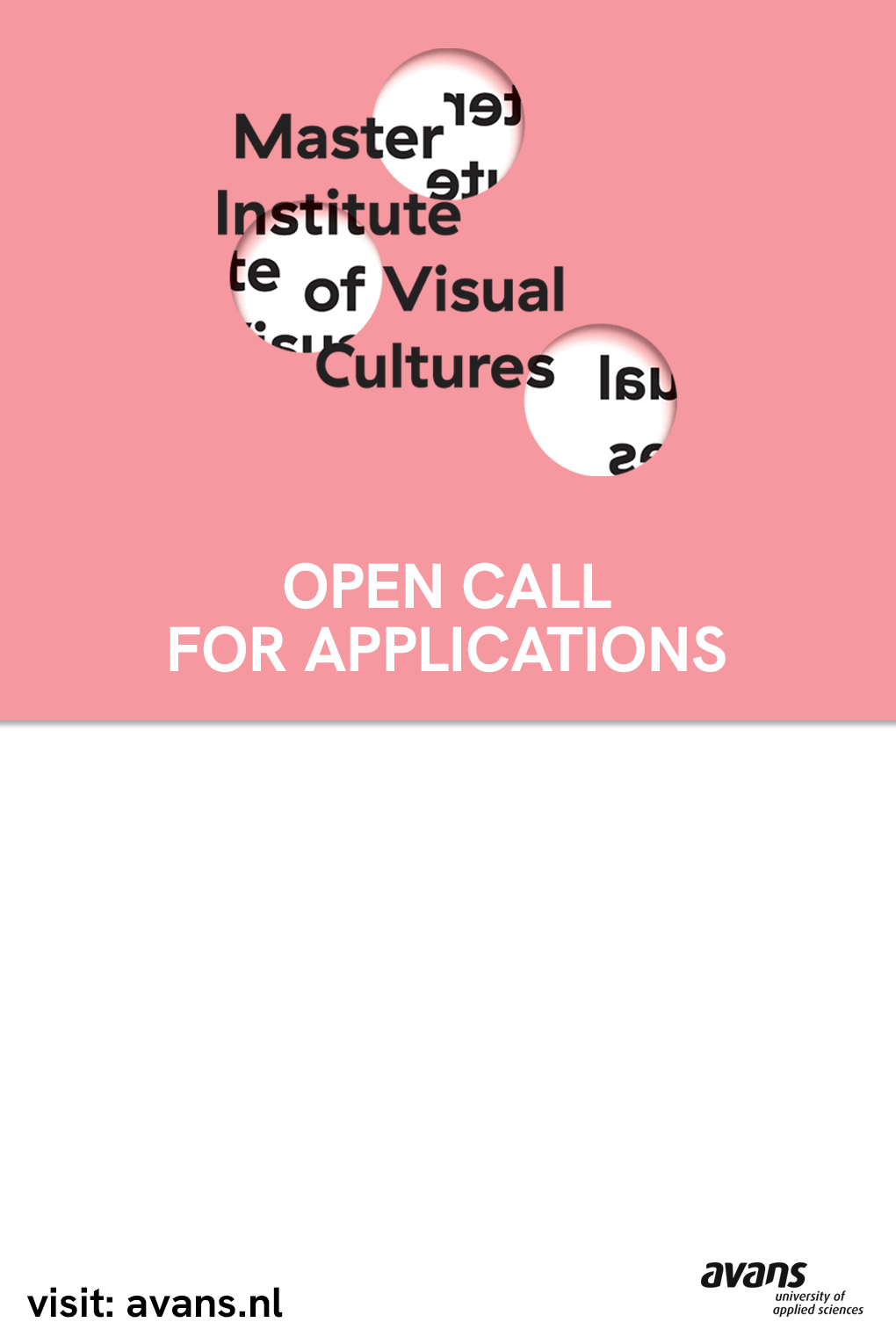http://www.gsa.ac.uk/
Perched on a swivel chair in the small, utilitarian office shared by the program’s five staff members, John Calcutt, program leader of Glasgow School of Art’s Master of Fine Art, is carefully, thoughtfully, and with good humor considering the strengths of the course he has worked on in various capacities since its inception in 1988. “I’d be horrified to think our job was to produce future Turner Prize winners,” he says. “Without wishing to sound pompous, it would undermine the integrity of the program.” During his tenure, both the GSA’s MFA and Scotland’s largest city have become internationally recognized for the breadth and depth of the artists they produce, including a number of Turner Prize winners and nominees.
Calcutt outlines the MFA’s history—its uncertain start prior to the appointment of its cofounder, Sam Ainsley, as the first program leader in 1990; the links to tutor David Harding’s influential Environmental Art undergraduate course, to which Ainsley contributed (alumni: Douglas Gordon, Christine Borland, David Shrigley); its slightly tenuous relationship, then and now, with the school’s fine art department—before showing me around its current quarters in the JD Kelly building on Hill Street that it shares with the school’s printmaking workshops. Formerly a nursing home, the building has, as its crumbling exterior testifies, seen better days. Part of Glasgow School of Art’s main Garnethill campus, it’s a short walk from the art nouveau Charles Rennie Mackintosh–designed art school completed in 1909 (currently swathed in scaffolding following 2014’s devastating fire) and the new, chicly austere Reid Building designed by Steven Holl that sits opposite “The Mack” on Renfrew Street.
As Calcutt leads me through the JD Kelly’s tightly packed studio spaces for the first time, past views of the city from above the bars and shops of Sauchiehall Street, it becomes apparent that while this building may be unfamiliar, as a resident of Glasgow the MFA program it houses is not. The MFA’s presence can be felt in the galleries and artist-led spaces, courtesy of the graduates who have stayed on to develop their practices in the city. The ever-growing list of internationally known and emerging artists working and exhibiting in Glasgow overlaps, to some extent, with the MFA program’s alumni roster: Claire Barclay (1993), Michael Fullerton (2002), Ciara Phillips (2006), Nicolas Party (2009, now based in Brussels), Corin Sworn (2009), Charlotte Prodger (2010), Hardeep Pandhal (2013), to name a few. And there are those Turner Prize winners too, some still based in the city, others now moved on: Simon Starling (1992), Richard Wright (1995), Martin Boyce (1997), Duncan Campbell (1998).
Calcutt, who joined Glasgow School of Art in 1987 and sat on the committee that created the MFA program, became its head following Ainsley’s departure in 2006. He assumed the role when Ainsley’s appointed successor, Dena Shottenkirk, left after just one year, and he too is moving on at the end of this term. Compared to the program’s reputation, the staff working alongside Calcutt is small. Graham Ramsay, one half of the artist duo Beagles and Ramsay and a 1997 GSA MFA alumnus, is the only full-time tutor. The other instructors—artist and writer Sarah Tripp, artist Christina McBride, and Francis McKee, writer and founding director of Glasgow International festival and, since 2006, director of Glasgow’s Centre for Contemporary Arts, a short but steep downhill walk from The Mack—teach part-time. Visiting lecturers for the Fall 2016 term ranged from artists and GSA MFA alumni Duncan Marquiss, Michael Stumpf, and Hayley Tompkins, to Kitty Anderson, curator of Glasgow’s The Common Guild, and academics Maria Fusco, Chancellor’s Fellow and Reader at Edinburgh College of Art, and Anna McLauchlan, Lecturer in Critical Human Geography at the University of Leeds.
Practice-based and multidisciplinary, Calcutt describes the MFA as being ultimately about “developing a sustainable practice as an artist.” The course draws on the resources and teaching skills of the wider school in addition to the core MFA staff through three discrete stages. First-year students engage in stages one and two, “Critical review of studio practice” and “Exploring studio practice,” which are supplemented by a mandatory research skills course and postgraduate elective courses. Stage three, “Consolidation of studio practice,” comprises the entire second year and requires an elective and a written dissertation supported by tutorials. First-years produce an interim show every May, with the final degree show following in June. “We deal with theoretical issues, contextual issues, but we’re not here to produce art theorists, art critics, or art historians,” explains Calcutt. “When we deal with those kind of things, it’s to help support practice. We stress this idea of exploring and understanding the various contexts in which a practice operates and develops, and that can be a whole range of contexts: philosophical, theoretical, political, social. But we’re not interested in those things as ends in themselves.”
While the MFA’s cohort at its inception comprised just eight Scotland-based students, the 2016 first-year intake was twenty-six, with six coming from within the UK (and only two from Scotland). The remainder span thirteen countries, including five from the US, four from South Korea, and one each from Ireland, South Africa, Iran, France, Switzerland, Denmark, Russia, Japan, Taiwan, New Zealand, and Poland. The student population for both years totals forty-nine, with Canada, Germany, Israel, and Thailand also represented. It is, then, an increasingly international group that reflects the profile of the program but also the shifts in higher education in the UK. Following cuts to government education spending, universities have increasingly been forced to operate as businesses, and in business money matters: in the 2016–17 academic year, the annual fee is £6,120 for students from the UK and European Union; for overseas students, it is £14,220.
“It’s been quite gradual,” says Calcutt, describing the increasingly international nature of the program, “and with students coming from lots of different cultural and educational backgrounds, you can’t assume there is a common set of references. Artists and staff can’t take anything for granted. The most important thing is this idea of the community; the community of the MFA and its relationship to the community of artists in the city. It’s something we talk about when we interview candidates and it’s an idea that is developed by [the program] being over two years. So when the first-years come in, they’re joining the second-years who have already learned that community; it’s always there to be entered, it doesn’t have to be reinvented every time.”
The approach of the MFA emphasizes group dynamics and the students’ relationships with Glasgow and its art institutions. Students are encouraged to network and develop connections both among their peers and beyond the JD Kelly’s walls, and to use them to direct the course’s instruction. All the tutors stress—almost to the point of self-deprecation about their own contribution to the program—that it is the students, rather than them, who set the teaching agenda. As Francis McKee, a twenty-year veteran of the program, puts it: “It’s really hard to know [what makes it a successful MFA] … It’s not like someone comes in and you turn them into something; they’ve already been practicing, they come in and want to reassess things and the MFA gives them a chance to do that.”
From speaking with the MFA’s tutors, past and present, the word that might best describe this approach is “bespoke.” With an emphasis on one-on-one tutorials complemented by a small number of group discussions, critiques, and occasional lectures, the program is defined by its responsiveness to each individual student. Following her text-based group discussion “Bearing Witness,” tutor Sarah Tripp reflected, “We’re working in the wake of the students’ practice. There’s no imposition of anyone’s agenda on any student and the course is structured to completely support the student in their development. So there’s no unifying pedagogical style or approach because there can’t be when the students are so diverse in their practice. It’s interdisciplinary too, so the students’ practices are shifting and moving all the time.”
On my visit, “Bearing Witness” gathered eleven students to the JD Kelly’s “crit space” to discuss the text “You Make Me Feel Mighty Real: On the Risk of Bearing Witness and the Art of Affective Labour” by the Berlin-based writer and critic Jan Verwoert. Prior to the two-hour session, students were instructed to read and annotate the text, and “choose a quotation which opposes, critiques or extends a section from the Verwoert essay.” They were also asked to choose an artwork that responded to the piece and prepare a short statement describing what the work “witnesses” and how. “Participation by everyone is built into the [discussion’s] structure,” Tripp explained. Seated around two pulled-together tables in the small but high-ceilinged, whitewashed room, most of the students expressed frustration with the text due to its roving, circuitous style. The artworks selected in response to Verwoert’s essay were as diverse as the students: a video of Trisha Brown’s A Man Walking Down the Side of a Building, a scene from Peter Greenaway’s film The Cook, The Thief, His Wife and Her Lover, works by Pierre Huyghe and Michel Houellebecq. After a tentative start, a wide-ranging conversation around the nature and role of contemporary art in a broader sense and the notion of art-making as affective labor developed, and accents from around the world filled the room. At the discussion’s end, Tripp invited the students to email her with suggestions of texts for future meetings.
In the same space a few days earlier, I was witness to a very different group dynamic at Crit Club, a series of weekly self-organized critiques. First- and second-year MFA students meet for two hours every Thursday evening to discuss the work of their peers, two at a time, transforming the ethos of a student-led curriculum into practice. (As Francis McKee tells me: “Students realize very quickly that you’re not going to be taught all the time. If you’re not a self-starter, you become one. It’s the only way to survive.”) Around twenty students crammed into the room, some sitting on the floor as chairs ran out. Cans of beer were cracked open and the atmosphere was informal but focused—a chance for the MFA community to take a look at itself on its own terms. A second-year student from England presented his densely narrated, slightly mournful film of around eleven minutes, attracting a variety of responses and questions: “I was wondering what it was trying to tell me”; “It reminded me of Hito Steyerl’s work”; “It wants you to believe it and then tells you that you shouldn’t”; and, to everyone’s amusement, “The tone of your voice is so sexual—when you said ‘Put it right in there,’ I was done.”
Affirming the multidisciplinary nature of the course, the second presentation was completely different. With all the chairs and tables removed and the lights switched off, a first-year American student blasted Beyoncé songs and danced enthusiastically as images of her younger self were projected on the wall. Soon, most of the students were dancing too, and after a short while a few heads popped around the door as if to ask, “Is this where the party’s happening?” It turned out it wasn’t. After thirty minutes the music stopped and questions and discussion ensued: “Is this part of your practice?”; “Why was it thirty minutes?”; “What was the significance of Beyoncé?” While initially explaining that this mini club event was based on a fellow student’s response to institutional pressures at her previous college, a way of “letting off steam,” the student was challenged to consider its significance in her own performative practice. And a very specific suggestion followed: “Rather than this being about letting off steam, it should be about creating more chaos.”
The informal nature of Crit Club seems, to some extent, to be an antidote to the “critical reappraisal” sessions the first-year students undertake upon entering the program and the formal group critiques that follow wherein first-years present to second-years and vice versa. These sessions form a crucial starting point for year one, beginning the process of unpacking and examining the elements of each student’s practice, prior to it being reassembled in the second year. While this examination begins with group critiques, it plays out primarily through the forty-five-minute one-on-one tutorials the students have throughout the year with all five staff and visiting lecturers. One second-year described in visceral terms what it feels like to spend the first year of the MFA dismantling what you thought you knew: “So you’ve got a practice and then you do the first year and you’re an absolute fucking mess by the end of it; we’re all a mess. And then you realize that that’s really good; it’s something that we all really needed but probably wouldn’t admit to.”
It’s a comment that encapsulates the strangely paradoxical intensity of this MFA. Compared to some programs, the time each student spends being taught seems relatively small, allowing them the opportunity to examine and reflect on their practice. This doesn’t equate to a lax, laissez-faire atmosphere, but rather the exact opposite. The emphasis on one-on-one tutorials, the demand that students determine their individual agendas, and the expectation of independent, rigorous critical engagement encourages a forensic reappraisal of each student’s practice. Tutor Christina McBride describes it as “a deep level of enquiry” that always puts the onus back on the student. “You don’t want students who are very dependent on a particular member of staff, a particular opinion. You want students to be able to use everything that is available and then shape their own position,” she says.
McBride’s view is echoed by former MFA visiting lecturer and editor/curator Gerrie van Noord, who taught in the program from 2003 to 2015. “The great quality of the program is that it’s not about producing work that can be exhibited and can enter the market, it’s about allowing people to consider who they want to be,” she says. Graham Ramsay has witnessed many changes and developments in the program, first as a student from 1995–97 when he was taught by Sam Ainsley and Calcutt, and then as a tutor. He stresses the need for the students to be able to “contextualize their work in a way that’s appropriate to their practice. None of us would be happy with vague talk about intuition; we want them to be able to identify what’s peculiar to their practice in as precise terms as possible. We are relatively analytic and forensic in wanting them to clarify in terms that are important to them.”
While this pedagogical approach has been consistent from the program’s early days to its present, one thing that most definitely has not remained the same is where the MFA calls home. Briefly based in the Mackintosh building in its early years, it has since roamed the Garnethill area, including a spell in a former girls’ high school, the Victorian-era McLellan Galleries, and then the Barnes Building—a 1960s-era office block—before arriving at JD Kelly. For the 2017–18 academic year it will move once more, as the school’s entire Fine Art department—part of which was displaced by the 2014 Mackintosh building fire—begins its relocation to the former Stow College, a solid, six-story former technical college built in the 1930s that sits on the edge of the nearby M8 motorway and within walking distance of the JD Kelly building. At Stow College, the MFA will have a whole floor to itself, a prospect which most of the first-years seemed to relish following a course visit to the still-to-be refurbished building. Although not significantly larger, the space allocated for MFA studios—two large, rectangular rooms with plenty of natural light—appeared to be slightly greater than at present. This was of clear concern to the students: one first-year’s attempt to measure the space with his overlong strides managed to create a brief murmur of disquiet when he incorrectly estimated one room’s square meterage. A GSA representative was on hand to provide a more accurate calculation.
As an institution undergoing many changes, particularly since the Mackintosh building fire, Glasgow School of Art is no stranger to student protests and disagreements. While writing this piece there was a noisy student demonstration outside the Reid building against plans to increase intake at the school by 25 percent—current student numbers in the undergraduate and graduate divisions stand at around 2300—with concerns expressed about the effect this will have on teaching. Around two hundred placard-carrying students from across the school complained that workshop and desk space was already being lost and, while praising the quality of tutors, said the school’s management was privileging the GSA “brand” over education. MFA students staged a smaller demonstration outside the Reid Building in March 2015 against the withdrawal of twenty-four-hour access to their studios: “The school cannot trade on the ‘Glasgow Miracle’ and Turner Prize–winning alumni while mistreating the students who study here,” said a student statement at the time. Limited access to studios was introduced as part of a package of post-fire security measures across the school. Protests proved unsuccessful: current student access to studios is 8 a.m. to 10 p.m. weekdays and 8 a.m. to 6 p.m. on weekends.
Perhaps it’s no surprise that perceived attacks on the culture of this hugely successful MFA provoke such a passionate response from its students. What comes across most strongly from talking to tutors and students is the transformative nature of the two years, and the strong culture of reciprocity that is engendered in the program. Crucially, with its relationship to the city’s internationally recognized art scene and its focus on the notion of artistic practice as something defined by artists themselves rather than the art market, the public gallery sector, or academia, it seems to create an environment that is a kind of intellectual sanctuary—a space for reappraisal and, perhaps, reinvention—but one that is also rooted in the actual reality of being a practicing artist. “Over two years you can fail, you can fuck up and still have time to recuperate,” explains Calcutt. “More risks can be taken.”
Failure, risks, fucking up—all are things that practicing artists, Turner Prize or not, have to deal with. It’s clearly no accident that, in the context of the GSA MFA, such real-world themes are explored and embraced. As Tripp puts it: “We expect a high level of self-motivation. And also a lot of courage. It takes courage to do this course—you have to be quite brave to go through it.”
—Chris Sharratt









